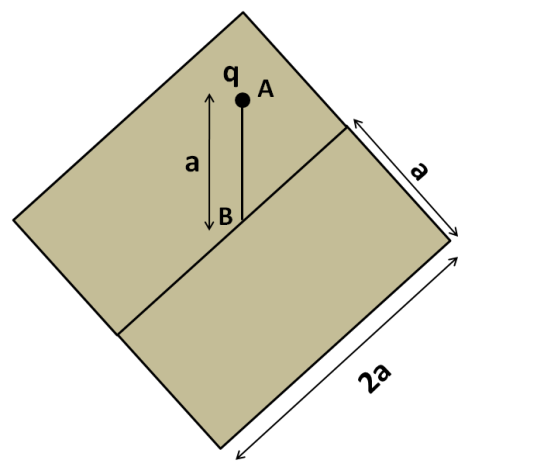
A point charge $q = 24{\varepsilon _0}$ Coulomb is kept above the midpoint of the edge of length $2a$ as shown in the figure. Line AB is perpendicular to the plane of the rectangle. Find the flux through the rectangle shown in the figure.

Answer
220.8k+ views
Hint: To solve this question, we need to use the gauss theorem. For this, we need to place the given charge in a closed volume, which has to be generated by using the rectangles given in the question. Then by using the unitary method we can find out the value of required flux through the given rectangle.
Complete step-by-step solution:
We know from the Gauss theorem that the total flux through a closed surface due to a point charge placed within it is given by
$\varphi = \dfrac{q}{{{\varepsilon _0}}}$................(1)
So we have to enclose the given point charge within a closed surface, symmetrically. We start by placing a similar rectangle adjacent to the given rectangle, so that the point charge is directly above the centre of the square thus formed, as shown in the figure below.

So now we have our point charge placed at above the centre of the square of side $2a$.
For generating a closed volume, we have to place five additional such squares of side $2a$ to form a cube of side $2a$. The charge will be symmetrically inside the cube. So from (1) the flux passing from this cube is
$\varphi = \dfrac{q}{{{\varepsilon _0}}}$
As the charge is symmetrically present within the cube, so the flux through each of the squares of side $2a$ is the same. As we have a total of six such squares, so the flux passing through the base square is
$\varphi ' = \dfrac{q}{{6{\varepsilon _0}}}$
Now, the base square of side $2a$ is made by placing two rectangles of dimensions $2a \times a$. As the charge is symmetrically placed with respect to their combination, as shown in the above figure, the flux passing through each of these rectangles is
$\varphi '' = \dfrac{q}{{12{\varepsilon _0}}}$
According to the question, $q = 24{\varepsilon _0}C$. Substituting this above, we finally get
$\varphi '' = 2N{m^2}/C$
Hence, the flux through the given rectangle is equal to $2N{m^2}/C$.
Note: The application of the gauss theorem does not depend on the symmetric placement of the charge within the closed surface. The charge just needs to be present within it. But for calculating the flux through a particular portion of the closed surface, we need the symmetry.
Complete step-by-step solution:
We know from the Gauss theorem that the total flux through a closed surface due to a point charge placed within it is given by
$\varphi = \dfrac{q}{{{\varepsilon _0}}}$................(1)
So we have to enclose the given point charge within a closed surface, symmetrically. We start by placing a similar rectangle adjacent to the given rectangle, so that the point charge is directly above the centre of the square thus formed, as shown in the figure below.

So now we have our point charge placed at above the centre of the square of side $2a$.
For generating a closed volume, we have to place five additional such squares of side $2a$ to form a cube of side $2a$. The charge will be symmetrically inside the cube. So from (1) the flux passing from this cube is
$\varphi = \dfrac{q}{{{\varepsilon _0}}}$
As the charge is symmetrically present within the cube, so the flux through each of the squares of side $2a$ is the same. As we have a total of six such squares, so the flux passing through the base square is
$\varphi ' = \dfrac{q}{{6{\varepsilon _0}}}$
Now, the base square of side $2a$ is made by placing two rectangles of dimensions $2a \times a$. As the charge is symmetrically placed with respect to their combination, as shown in the above figure, the flux passing through each of these rectangles is
$\varphi '' = \dfrac{q}{{12{\varepsilon _0}}}$
According to the question, $q = 24{\varepsilon _0}C$. Substituting this above, we finally get
$\varphi '' = 2N{m^2}/C$
Hence, the flux through the given rectangle is equal to $2N{m^2}/C$.
Note: The application of the gauss theorem does not depend on the symmetric placement of the charge within the closed surface. The charge just needs to be present within it. But for calculating the flux through a particular portion of the closed surface, we need the symmetry.
Recently Updated Pages
[Awaiting input: Please provide the content from "Ask AI Response," "Competitor 1," and "Competitor 2," so I can perform the analysis and synthesize the requested metadata and headings.]

Young’s Double Slit Experiment Derivation Explained

A square frame of side 10 cm and a long straight wire class 12 physics JEE_Main

The work done in slowly moving an electron of charge class 12 physics JEE_Main

Two identical charged spheres suspended from a common class 12 physics JEE_Main

According to Bohrs theory the timeaveraged magnetic class 12 physics JEE_Main

Trending doubts
JEE Main 2026: Application Form Open, Exam Dates, Syllabus, Eligibility & Question Papers

Derivation of Equation of Trajectory Explained for Students

Hybridisation in Chemistry – Concept, Types & Applications

Understanding the Angle of Deviation in a Prism

How to Convert a Galvanometer into an Ammeter or Voltmeter

Degree of Dissociation: Meaning, Formula, Calculation & Uses

Other Pages
JEE Advanced Marks vs Ranks 2025: Understanding Category-wise Qualifying Marks and Previous Year Cut-offs

Dual Nature of Radiation and Matter Class 12 Physics Chapter 11 CBSE Notes - 2025-26

Ideal and Non-Ideal Solutions Explained for Class 12 Chemistry

Understanding the Electric Field of a Uniformly Charged Ring

Understanding Electromagnetic Waves and Their Importance

Essential Derivations for CBSE Class 12 Physics: Stepwise & PDF Solutions




